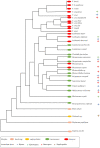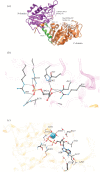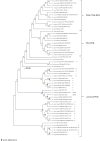Phosphoglycerate kinase: structural aspects and functions, with special emphasis on the enzyme from Kinetoplastea
- PMID: 33234025
- PMCID: PMC7729029
- DOI: 10.1098/rsob.200302
Phosphoglycerate kinase: structural aspects and functions, with special emphasis on the enzyme from Kinetoplastea
Abstract
Phosphoglycerate kinase (PGK) is a glycolytic enzyme that is well conserved among the three domains of life. PGK is usually a monomeric enzyme of about 45 kDa that catalyses one of the two ATP-producing reactions in the glycolytic pathway, through the conversion of 1,3-bisphosphoglycerate (1,3BPGA) to 3-phosphoglycerate (3PGA). It also participates in gluconeogenesis, catalysing the opposite reaction to produce 1,3BPGA and ADP. Like most other glycolytic enzymes, PGK has also been catalogued as a moonlighting protein, due to its involvement in different functions not associated with energy metabolism, which include pathogenesis, interaction with nucleic acids, tumorigenesis progression, cell death and viral replication. In this review, we have highlighted the overall aspects of this enzyme, such as its structure, reaction kinetics, activity regulation and possible moonlighting functions in different protistan organisms, especially both free-living and parasitic Kinetoplastea. Our analysis of the genomes of different kinetoplastids revealed the presence of open-reading frames (ORFs) for multiple PGK isoforms in several species. Some of these ORFs code for unusually large PGKs. The products appear to contain additional structural domains fused to the PGK domain. A striking aspect is that some of these PGK isoforms are predicted to be catalytically inactive enzymes or 'dead' enzymes. The roles of PGKs in kinetoplastid parasites are analysed, and the apparent significance of the PGK gene duplication that gave rise to the different isoforms and their expression in Trypanosoma cruzi is discussed.
Keywords: Trypanosoma; domains; metabolism; moonlighting protein; phosphoglycerate kinase; protists.
Conflict of interest statement
We declare we have no competing interests.
Figures





 , PGK domain having lost substrate (3PGA)-binding residues
, PGK domain having lost substrate (3PGA)-binding residues  , triosephosphate isomerase domain
, triosephosphate isomerase domain  , HTH domain
, HTH domain  , transmembrane segment
, transmembrane segment  , PAS domain
, PAS domain  , cyclic-nucleotide binding-domain
, cyclic-nucleotide binding-domain  . Import sequences and inserts identified in PGK isoenzymes through experimental and theoretical studies: putative PTS1
. Import sequences and inserts identified in PGK isoenzymes through experimental and theoretical studies: putative PTS1  , putative lysosome
, putative lysosome  , PGKA-like insert sequence
, PGKA-like insert sequence  .
.
References
Publication types
MeSH terms
Substances
LinkOut - more resources
Full Text Sources

